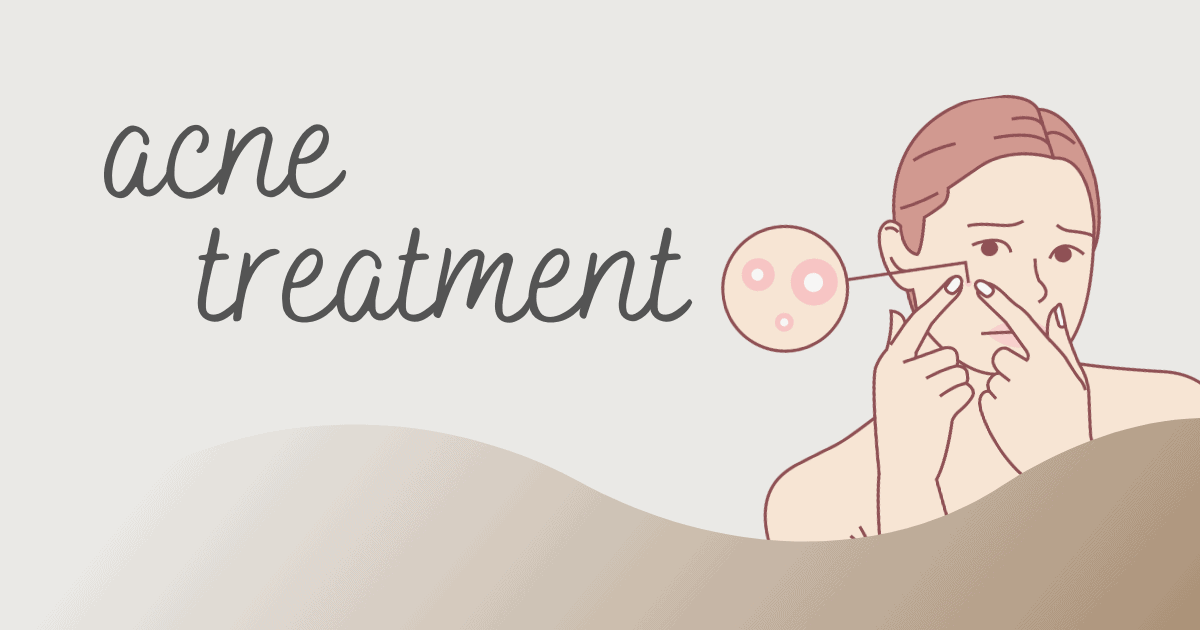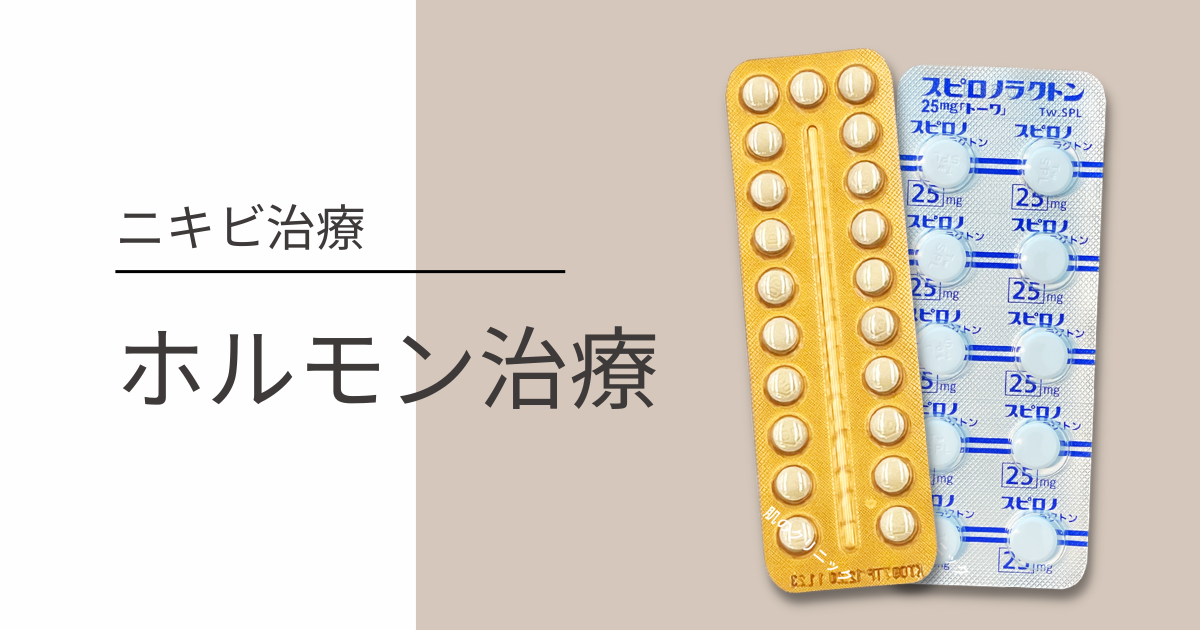Isotretinoin

Isotretinoin is an oral medication for the treatment of acne. This medication belongs to the “retinoid” family of vitamin A derivatives.
The trade name for isotretinoin is Accutane, which is the trade name of the original drug. In addition to Accutane, other trade names for isotretinoin include Roaccutane, Isotroin, Sotolet, Claravis and Aknetrent.
It is recommended in Western acne treatment guidelines for moderate to severe acne and has been used worldwide for over 30 years1, 2.
The reason why isotretinoin is not approved in Japan is that acne is not a disease that causes physical discomfort and is often interpreted as a “cosmetic” rather than a “disease treatment,” making it difficult to approve drugs with serious side effects such as teratogenicity.
Efficacy of Isotretinoin for Acne
The results of isotretinoin treatment for our patients show an efficacy rate of over 98% and a recurrence rate* of less than 30%.
This is not significantly different from the efficacy and improvement rates of isotretinoin in the literature. A study of moderate acne patients treated with 20 mg/day isotretinoin over approximately 6 months reported a very high efficacy rate with 98.99% of patients improving, including 98.3% who improved dramatically.3
A study of 1 mg/kg/day isotretinoin treatment over approximately 5 months in patients with severe acne reported a dose-dependent increase in efficacy with 90% of patients experiencing at least a 95% reduction in inflammatory acne 4.
Considering that most patients treated at our clinic had already received previous antibiotic and ointment treatments that failed to show improvement, isotretinoin is a highly effective treatment with a low recurrence rate.
Even for mild acne, we prescribe isotretinoin to patients who have failed other treatments and have recurrences; low-dose therapy with isotretinoin at 0.5 mg/kg/day or less is often effective 5, 6.
For moderate or more severe acne, we aim for early improvement in order to avoid scarring as much as possible.
*Recurrence is defined as a return of the number of new pimples to 1/3 or more of the pre-treatment state after treatment is completed.
Isotretinoin Mechanism of Action
Isotretinoin contains no antibiotics to kill acne bacteria, no hormones to suppress male hormones, and no steroids to calm inflammation.
What is the mechanism by which isotretinoin treats acne?
Although there are many unknowns about isotretinoin’s action, three main mechanisms are known.
- Retraction of sebaceous glands
-
Oral isotretinoin has the effect of shrinking the sebaceous glands and greatly reducing sebum secretion.7 20 This action prevents the acne-causing bacteria, Acne bacillus, from taking hold and reduces the number of acne-causing bacteria better than antibiotics.21
Because isotretinoin promotes apoptosis of the sebaceous glands,8 a decrease in sebum production is observed to some extent after treatment. However, since the contracted sebaceous glands return to their original size, most of the sebum will return after treatment.
- Normalizes sebaceous gland cells
-
Isotretinoin acts on cells to normalize sebaceous gland cells and epidermal cells.9
Although different from acne, isotretinoin has been shown to be effective in treating sebaceous hyperplasia, a condition in which sebaceous glands are overdeveloped and enlarged, and it has been reported that a large percentage of sebaceous glands remain normal after treatment is completed.10
When skin cells work normally, abnormal keratinization (thickening of the skin and clogging of pores) no longer occurs, and when pores are no longer clogged, inflammation of acne no longer occurs.
- Anti-inflammatory action
-
Isotretinoin has also been reported to have “immunomodulating” properties that normalize the cellular immune response to acne bacteria.
In other words, it prevents an excessive immune response and worsening of acne inflammation.11, 12
Who may not be eligible for isotretinoin treatment.
The following persons may not be eligible for “Acne Treatment with Isotretinoin”. Please consult us.
- Those who are with only mild acne (isotretinoin is indicated for acne that did not improve after treatment covered by Japanese health insurance, or moderate or severe acne that recurs repeatedly).
- Those who are under 15 years of age (consult your doctor as it may stop long bone growth).
- Those who are with a history of ulcerative colitis, Crohn’s disease or serious liver disorders.
- Those suffering from mental illness (Generally, patients suffering from depression, schizophrenia or other mental illnesses are not eligible for treatment). Patients who are currently fully recovered should discuss with doctors).
- Those who are pregnant, under breast feeding, planning to get pregnant within a year
- Patients undergoing laser or light hair removal (during treatment, a period of one month is necessary after stopping treatment)
- Those who had LASIK treatment in the past 6 months
- Those who have aspirin asthma or are allergic to isotretinoin products/parabens/soy/peanuts.
Side effect
Isotretinoin has various side effects and risks. Our doctors will explain the side effects on a sheet and perform periodic blood and urine tests.
The side effects of isotretinoin are many and varied, but the most common are dry skin and dry mucous membranes of the mouth, nose, and eyes. This side effect occurs in almost 100% of patients. Dryness can cause dermatitis, angulus, cheilitis, nose bleeds, and dry eyes.
Red faces and nosebleeds are also common side effects.13 Blood tests may show various abnormalities such as liver dysfunction and lipid abnormalities.
Although very rare, serious side effects have been reported including eye abnormalities, pancreatitis, hepatitis, ulcerative colitis, Crohn’s disease, anaphylactic shock, Stevens-Johnson syndrome, and suicide attempts.
A serious side effect for women is fetal teratogenicity.23 24 26 Contraception must be used during oral administration and for 6 months after discontinuation. A pregnancy prevention program in accordance with the iPLEDGE program in the U.S. is also important.14 24 25
Side effects will be explained by the physician at the initial visit, so please do not hesitate to discuss any concerns you may have.
Isotretinoin treatment at our clinic
During the first month of treatment, approximately 30% of patients experience a transient exacerbation of acne, but on average, acne improves within 2 to 3 months.
After the acne improves, treatment should be continued to prevent recurrence.
If acne improvement is lackluster, the dose of the drug is increased. The dose at the start of treatment is 0.5 mg to 1.0 mg/kg/day, with a maximum dose of 2 mg/kg/day.13
Some clinics don’t give clear instructions to patients on how to use isotretinoin properly and fail to manage side effects. This leads to low effectiveness and high recurrence rates. It’s crucial to follow the recommended dosage and treatment duration.
Our clinic has provided isotretinoin treatment to over 15,000 patients for more than 16 years, including our previous practice. Hada no Clinic specializes in treating severe acne cases that don’t respond to dermatology. You can trust us for expert advice and care.
Duration of treatment
One course of treatment usually lasts about 6 months, but it can be extended up to 8 months if necessary.
According to recent studies, long-term use of oral medication may lower the chances of acne recurring.28
At our clinic, we use medium to high doses of isotretinoin to treat acne, and once it has improved, we continue with a maintenance treatment at low doses.
After completing a 6 to 8-month course of treatment, it’s recommended to take a break of at least 2 months (ideally 4 months). If acne recurs, a second course of treatment may be needed.
Recurrent acne after treatment is usually less severe than before. With repeated treatments, we aim to achieve a state where acne no longer bothers you.
*Recurrence is defined as a return of the number of new pimples to 1/3 or more of the pre-treatment state after treatment is completed.
Treatment cases of Isotretinoin
If you would like to see case photos of acne treatment with isotretinoin, please click below.
※The patients whose photos are posted have given their consent for the publication. Please rest assured that we will not publish them without permission.
Case photo 1 (Severe acne on the face)
Photo taken at the initial visit
At the initial visit, the patient had multiple large pimples with severe inflammation all over his face. The pimples had clustered together to form a large swollen lump, which is a severe form of acne called nodulocystic acne.

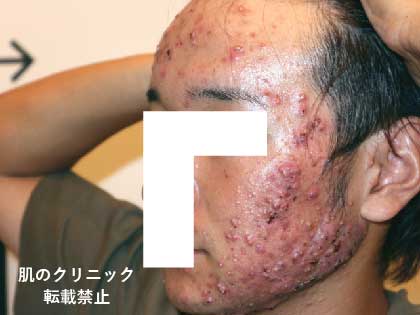
History of the patient’s visit
The patient, a male in his 20s, had been suffering from facial acne since the age of 15 and had received almost all insurance treatments including antibiotics, topical agents, vitamin supplements, and traditional Chinese medicine from a dermatologist for many years. However, his acne had not improved at all, so he came to our clinic.
Treatment at our clinic
To prevent the formation of pitted or crater-like scars after the acne is healed, we immediately started treatment with isotretinoin to improve the patient’s acne.
Photo after 5 months of treatment
After five months of isotretinoin treatment, the patient’s pustules and nodules disappeared, and the papules and comedones almost disappeared.
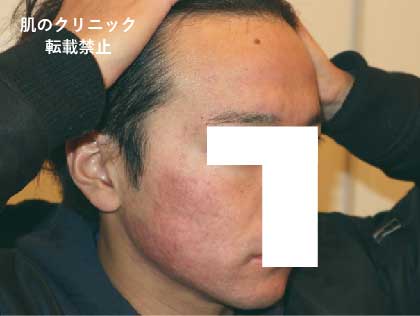
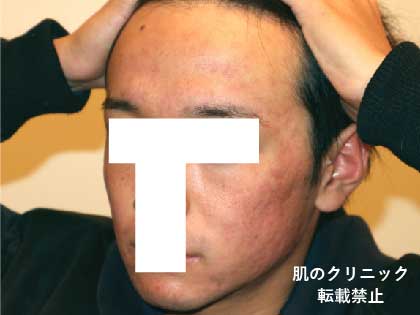
Explanation
In cases of severe acne, if ineffective treatment is continued for years without the acne improving, the patient may be left with atrophic scars (skin indentations) that will never heal.
Many patients who come to our clinic have already formed multiple acne scars, but early treatment is important for severe acne to prevent further scarring.
Case photo 2 (severe acne on face)
Photo taken at the initial visit
The patient has developed numerous pustules with hardening and the entire face is swollen. Acne has also formed on the skin around the eyes, causing the face to deform significantly. This is a severe type of acne called “nodular cystic acne” in which abscesses combine under the skin to form a single mass.
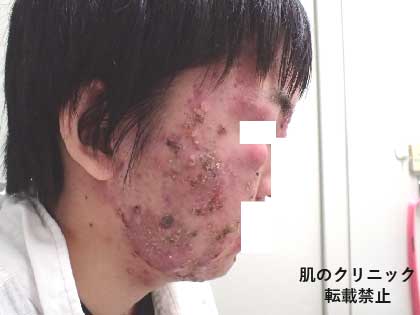
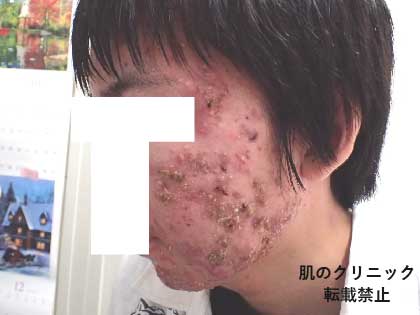
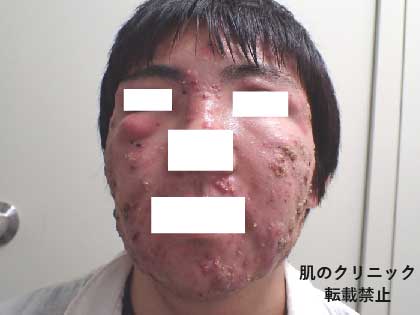
History of the patient’s visit
The patient is a male in his late teens. He started developing acne four years ago and received treatment including oral antibiotics, adapalene, benzoyl peroxide, steroids, and traditional Chinese medicine for three years at a dermatology clinic, but his acne did not improve.
Two months ago, his acne inflammation worsened, and he began to develop multiple hard nodules, so he was transferred from the local clinic to a university hospital. However, since the acne did not improve even with the treatment at the university hospital, the patient’s parents wished to transfer him to our clinic and he came to us for consultation.
Treatment at our clinic
At the initial visit, the patient had a fever and blood tests showed signs of systemic inflammation with WBC 16400 and CRP 4.17. Differential diagnoses were made to rule out underlying conditions that could cause pyoderma such as systemic lupus erythematosus (SLE), sarcoidosis, gammaglobulinemia, rheumatism, viral hepatitis, and malignant lymphoma, but all were negative.
Because cluster acne has a high risk of leaving significant scars, treatment with isotretinoin was started immediately.
Photo after 5 months of treatment
Two weeks after starting treatment with isotretinoin, multiple abscesses continued to appear, but gradually improved from one month onwards. After five months, the inflammation of acne was completely healed. Redness of acne scars remains strong, and unevenness is still visible, but new acne has disappeared and the swelling of the entire face has subsided.
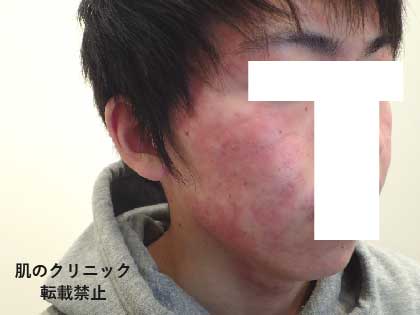
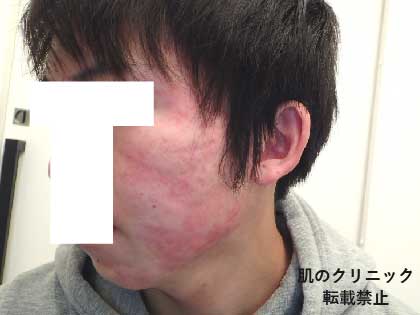
Photo after 8 months of treatment
After completing the treatment period of one course, low-dose maintenance therapy with Isotretinoin was carried out to prevent recurrence. During the treatment, the patient’s skin was moisturized with cosmetics containing regenerative factors and placenta (EG white lotion and cream), and acne scar treatment was performed using peeling.
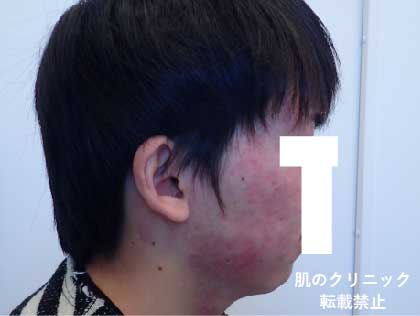
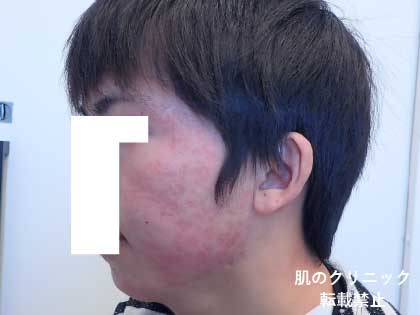
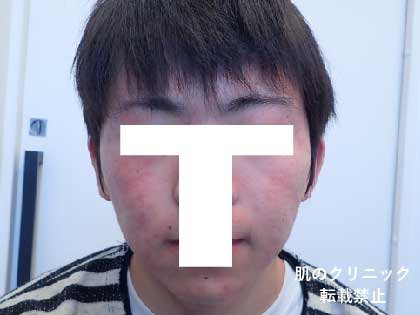
*I changed my camera to a new one, but the settings aren’t working properly and the pictures are coming out too pale and bluish.
Explanation
This patient had been taking antibiotics for 3 years at a dermatology clinic without any improvement. If severe acne is not treated early, acne scars can remain for life.
Treatment with isotretinoin is not the “last resort” in acne treatment. For severe acne, early treatment is necessary to prevent scarring.
Case photo 3 (Acne with pus on the face and facial line)
Photo taken at the initial visit
Acne is prevalent from the neck and jawline to the forehead. Many acne scars such as hyperplastic and atrophic scars (depressed scars) and post-inflammatory hyperpigmentation are also observed.
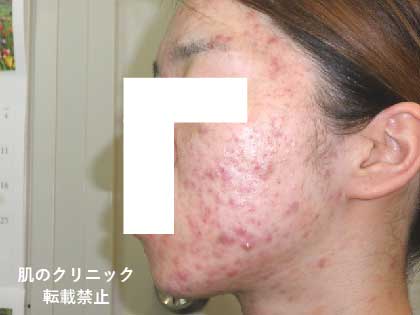
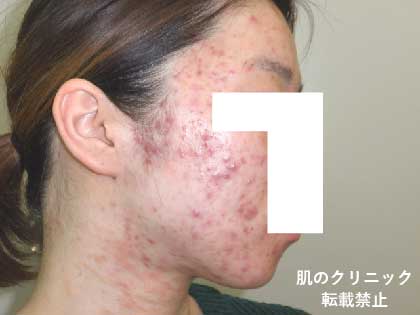
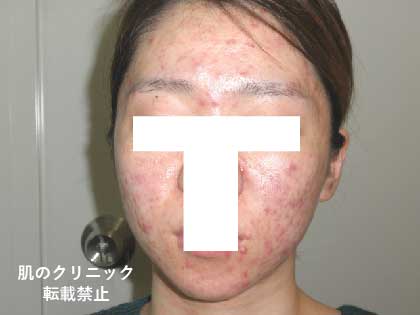
History of the patient’s visit
The patient is a woman in her 20s who has been suffering from acne for 10 years. She has been receiving insurance treatments such as oral antibiotics, vitamins, and Chinese medicine at a dermatology clinic for many years, but has not seen any improvement.
She visited a beauty dermatology clinic a year ago and received six sessions of photofacial, 12 sessions of chemical peeling and ion introduction. However, her condition worsened further six months ago, so she received treatments such as calming packs and keratin removal at an esthetic salon. Nevertheless, since there was no improvement at all, she came to our clinic.
Treatment at our clinic
We treated her acne with isotretinoin. In addition, we prescribed EG White Lotion and EG White Cream, which contain regenerating factors and placenta, for skincare, and performed salicylic acid macrogol peeling for redness caused by acne.
Photo after 1 month of treatment
The condition of the skin one month after treatment is that some of the acne has improved, but the acne on the face line and neck has worsened.
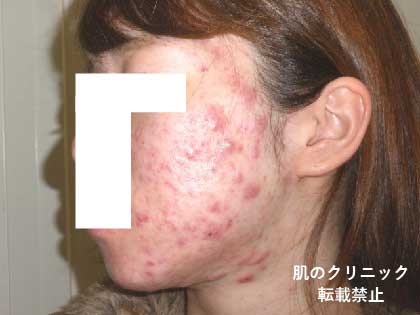
Photo after 5 months of treatment
After 5 months of treatment, new acne has almost disappeared. By combining skincare with EG White Lotion and EG White Cream and peeling with Isotretinoin treatment, strong redness of acne scars has become less noticeable.
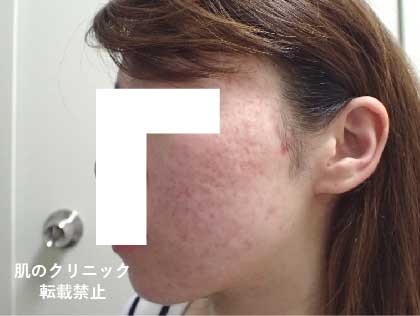
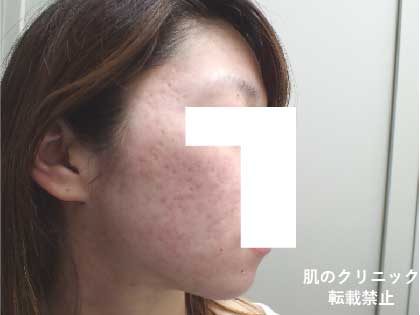
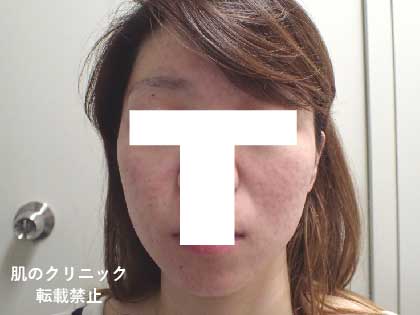
Explanation
When taking isotretinoin orally, about 30% of patients experience transient worsening of acne in the first month.
If the worsening is severe, the dosage may be increased or medication to reduce inflammation may be prescribed.
Despite receiving various treatments over the years with no improvement, there were many acne scars that would remain for a lifetime at the time of the initial consultation. However, the patient was always bright and positive about treatment, which left a strong impression.
Case photo 4 (acne on chin and neck)
Photo taken at the initial visit
There are many red pimples mainly around the chin, jawline, and neck.
For women, acne during adolescence often appears on the T-zone and cheeks, while in adulthood, it tends to occur on the chin, jawline, and neck.

History of the patient’s visit
This woman has been suffering from acne for 15 years and has received various treatments such as sulfur camphor lotion, oral antibiotics, traditional Chinese medicine, and vitamins from dermatologists for many years.
After that, she continued treatment with oral contraceptive pills for more than a year at another hospital, but her condition worsened. For the past 2 years, the patient has been unable to walk without covering her acne with a mask, which brought her to our clinic for treatment.
Treatment at our clinic
We conducted acne treatment with isotretinoin and skin care with EG White lotion and cream.
Photo after 4 months of treatment
The inflammation of acne has subsided and there are no new pimples, including small comedones. The pigmentation of acne scars has become less noticeable, and the overall skin texture has improved.
In the post-treatment photos, the neck looks slimmer, but it was reportedly due to the patient’s weight loss during the treatment.

Explanation
Isotretinoin has the effect of promoting skin turnover and improving post-acne hyperpigmentation.
In addition, using compounded cosmetics formulated for moisturizing and whitening can help balance the skin’s moisture and oil levels, and increase its moisture-retaining ability. This can lead to improved skin tone and texture.
Case photo 7 (white and red acne on face)
Photo taken at the initial visit
The entire face, especially the cheeks and chin, have numerous red inflammatory acne and white pus caused by acne. Additionally, there are also many depressed acne scars present.

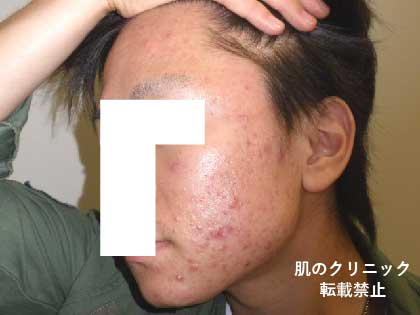
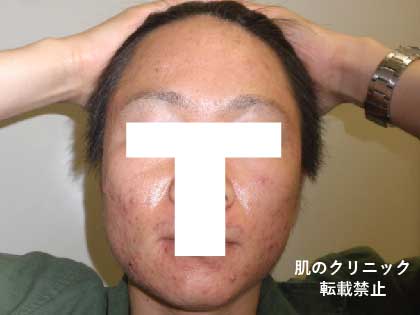
History of the patient’s visit
The patient is a man in his 20s. He started getting acne seven years ago, and for the past four years, he has been experiencing frequent papules and pustules all over his face.
He has tried various over-the-counter acne treatments, exfoliating soaps, antibiotics, vitamins, herbal remedies, topical treatments such as adapalene and benzoyl peroxide, and light therapy, but none of them have been effective. That’s why he came to our clinic for treatment.
Treatment at our clinic
We started the treatment of isotretinoin for his acne.
Photo after 1 month of treatment
After one month of treatment, the patient developed numerous pimples with pus, and the severity of the condition worsened. Therefore, the dosage of isotretinoin was increased.
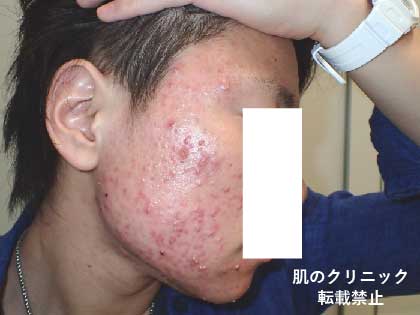
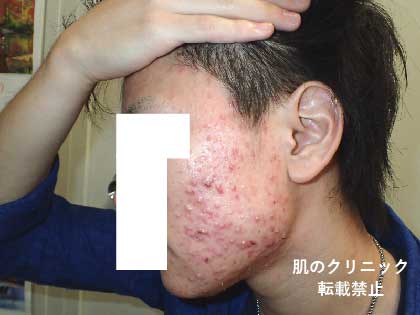
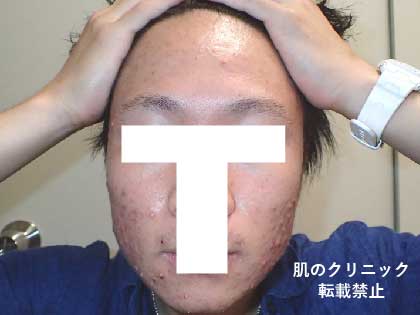
Photo after 5 months of treatment
After three months, there was little improvement, so the dose of isotretinoin was increased. After five months, all the acne disappeared. However, since acne scars may last a lifetime once they have formed, some depressions remain.


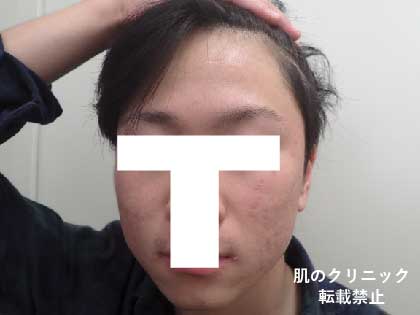
Explanation
“Red acne” is a colloquial term for acne with red, swollen inflammation. “White acne” refers to acne with pus. “Black acne” is when the oil in the head of the acne oxidizes and turns black. It is also known as blackheads.
Classifying acne by its color is just a general colloquialism and there is no significant difference in treatment methods. The important thing is to improve the clogging of the sebaceous glands, which is the cause of acne. Therefore, it is necessary to choose an appropriate treatment based on the patient’s symptoms and condition.
In cases like this patient, where improvement with isotretinoin is inadequate, it is necessary to increase the amount of medication.
Some patients may dislike the temporary initial worsening of acne, but since it is explained in advance, few patients interrupt their treatment midway. As the patient in this case was positive about the treatment, his acne was able to be cured.
Case photo 9 (acne on chest and back)
Photo taken at the initial visit
The patient had numerous inflamed acne lesions and redness (erythema and papules) on the entire back, as well as scattered lesions on the chest. There were also many instances of dark pigmentation, with some areas showing raised acne scars (hypertrophic scars).

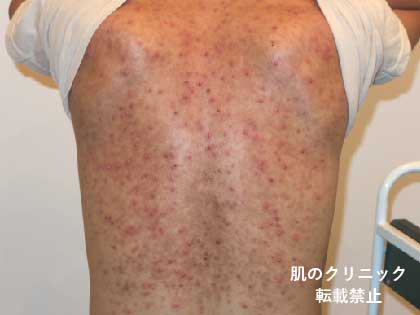
History of the patient’s visit
This patient is a male in his 20s who has been troubled by acne on his face, back, chest, and other parts of his body since he was 12 years old.
He has been receiving acne treatment at a dermatology clinic for 9 years, using antibiotics such as minocycline and roxithromycin, as well as topical treatments such as benzoyl peroxide and adapalene. However, since there was no improvement at all, he came to our clinic for treatment.
Treatment at our clinic
We started the treatment of isotretinoin for his acne.
Photo after 5 months of treatment
After receiving treatment for 5 months, the patient did not experience any new acne breakouts. The inflammation caused by acne on the chest and back has decreased, resulting in an improvement in the skin tone.
However, there are still several raised acne scars called “hypertrophic scars” on the chest. The back still looks uneven due to reddish-brown pigmentation caused by the previous acne.


Explanation
As in the case of this patient, if acne continues to recur for a long period of time, acne scars are bound to remain.
It is not difficult to cure acne with appropriate treatment. However, since acne scars remain for life, it is important to receive acne treatment early on.
Early treatment of acne can prevent keloids and scars.
Isotretinoin Treatment Pricing
As isotretinoin is not an approved drug in Japan, our clinic provides it under strict safety management protocols with dermatologist prescription. The dosage of isotretinoin varies depending on the severity of acne, body weight, and skin condition. (※Price revision effective from May 13, 2025)
Isotretinoin (Aknetrent) Pricing
| Dosage | Price (incl. tax) |
|---|---|
| 10mg 30-day supply | ¥7,920 |
| 20mg 30-day supply | ¥9,900 |
| 40mg 30-day supply | ¥19,800 |
| 60mg 30-day supply | ¥29,700 |
Monthly Cost (Including Consultation & Tests)
Isotretinoin treatment is recommended to be continued for a standard 6-month period with monthly consultations and tests, based on international guidelines.
| Item | Initial Visit (incl. tax) |
Follow-up Visit (incl. tax) |
|---|---|---|
| Consultation Fee | ¥3,850 | ¥1,650 |
| Isotretinoin 10mg 30-day supply |
¥7,920 | ¥7,920 |
| Blood Test Fee | ¥3,608 | ¥3,608 |
| Total | ¥15,378 | ¥13,178 |
| Item | Initial Visit (incl. tax) |
Follow-up Visit (incl. tax) |
|---|---|---|
| Consultation Fee | 3,850 yen | 1,650 yen |
| Isotretinoin 20mg 30-day supply |
¥9,900 | ¥9,900 |
| Blood Test Fee | 3,608 yen | 3,608 yen |
| Total | ¥17,358 | ¥15,158 |
| Item | Initial Visit (incl. tax) |
Follow-up Visit (incl. tax) |
|---|---|---|
| Consultation Fee | 3,850 yen | 1,650 yen |
| Isotretinoin 40mg 30-day supply |
¥19,800 | ¥19,800 |
| Blood Test Fee | 3,608 yen | 3,608 yen |
| Total | ¥27,258 | ¥25,058 |
| Item | Initial Visit (incl. tax) |
Follow-up Visit (incl. tax) |
|---|---|---|
| Consultation Fee | 3,850 yen | 1,650 yen |
| Isotretinoin 60mg 30-day supply |
¥29,700 | ¥29,700 |
| Blood Test Fee | 3,608 yen | 3,608 yen |
| Total | ¥37,158 | ¥34,958 |
※For females with childbearing potential, an additional urine test (pregnancy test ¥1,056) is required

List of references/websites
- A. Nast, (2012) “European evidence-based (S3) guidelines for the treatment of acne.” J Eur Acad Dermatol Venereol. GUIDELINES 2012
- Andrea L. Zaenglein, (2016) “Guidelines of care for the management of acne vulgaris.” J Am Acad Dermatol. May 2016Volume 74, Issue 5, Pages 945–973.e33
- Dhaked DR, (2016) “A randomized comparative trial of two low-dose oral isotretinoin regimens in moderate to severe acne vulgaris.” Indian Dermatol Online J. 2016 Sep-Oct;7(5):378-385. PMID: 27730033
- Costa CS, (2018) “Oral isotretinoin for acne.” Cochrane Database Syst Rev. 2018 Nov 24;11:CD009435. doi: 10.1002/14651858.CD009435.pub2. PMID: 30484286
- Sardana K, (2010) “Efficacy of low-dose isotretinoin in acne vulgaris.” Indian J Dermatol Venereol Leprol. 2010 Jan-Feb;76(1):7-13. doi: 10.4103/0378-6323.58672. PMID: 20061724
- Amichai B, (2006) “Low-dose isotretinoin in the treatment of acne vulgaris.” J Am Acad Dermatol. 2006 Apr;54(4):644-6. PMID: 16546586
- Orfanos CE, (1998) “Oral retinoids in the treatment of seborrhoea and acne.” Dermatology. 1998;196(1):140-7. PMID: 9557249
- Nelson AM, (2008) “Neutrophil gelatinase-associated lipocalin mediates 13-cis retinoic acid-induced apoptosis of human sebaceous gland cells.” J Clin Invest. 2008 Apr;118(4):1468-78. doi: 10.1172/JCI33869. PMID: 18317594
- Eichenfield LF, (1991) “Acne: current concepts of pathogenesis and approach to rational treatment.” Pediatrician. 1991;18(3):218-23. PMID: 1835004
- Sandra Tagliolatto, (2015) “Sebaceous hyperplasia: systemic treatment with isotretinoin” An Bras Dermatol. 2015 Mar-Apr; 90(2): 211–215. doi: 10.1590/abd1806-4841.20153192 PMID: 25830991
- Orfanos CE, (1983) “Evidence for anti-inflammatory activities of oral synthetic retinoids: experimental findings and clinical experience.” Br J Dermatol. 1983 Jul;109 Suppl 25:55-60. PMID: 6222758
- Dispenza MC, (2012) “Systemic isotretinoin therapy normalizes exaggerated TLR-2-mediated innate immune responses in acne patients.” J Invest Dermatol. 2012 Sep;132(9):2198-205. doi: 10.1038/jid.2012.111. Epub 2012 Apr 19. PMID: 22513780
- Roche “Accutane (isotretinoin) Capsules Label” https://www.accessdata.fda.gov/drugsatfda_docs/label/2002/18662s051lbl.pdf 2019.05.07 アクセス
- ”iPLEDGE program” https://www.ipledgeprogram.com/iPledgeUI/home.u 2019.05.07 アクセス
- 厚生労働省 “アキュテイン(ACCUTANE)(わが国で未承認の難治性ニキビ治療薬)に関する注意喚起について” https://www.mhlw.go.jp/topics/bukyoku/iyaku/kojinyunyu/050609-1b.html 2019.05.07 アクセス
- Lee SY, (2016) “Does exposure to isotretinoin increase the risk for the development of inflammatory bowel disease? A meta-analysis.” Eur J Gastroenterol Hepatol. 2016 Feb;28(2):210-6. doi: 10.1097/MEG.0000000000000496. PMID: 26545085
- Layton AM, (1993) “Isotretinoin for acne vulgaris–10 years later: a safe and successful treatment.” Br J Dermatol. 1993 Sep;129(3):292-6. PMID: 8286227
- Blasiak RC, (2013) “High-dose isotretinoin treatment and the rate of retrial, relapse, and adverse effects in patients with acne vulgaris.” JAMA Dermatol. 2013 Dec;149(12):1392-8. doi: 10.1001/jamadermatol.2013.6746. PMID: 24173086
- Rademaker M, (2016) “Making sense of the effects of the cumulative dose of isotretinoin in acne vulgaris.” Int J Dermatol. 2016 May;55(5):518-23. doi: 10.1111/ijd.12942. Epub 2015 Oct 15. PMID: 26471145
- King K, (1982) “A double-blind study of the effects of 13-cis-retinoic acid on acne, sebum excretion rate and microbial population.” Br J Dermatol. 1982 Nov;107(5):583-90. doi: 10.1111/j.1365-2133.1982.tb00410.x PMID: 6215056
- Leyden JJ, (1982) “Effect of 13-cis-retinoic acid on sebum production and Propionibacterium acnes in severe nodulocystic acne.” Arch Dermatol Res. 1982;272(3-4):331-7. doi: 10.1007/bf00509064 PMID: 6219631
- Rapid response to:Laser refractive eye surgery, “LASIK and isotretinoin: An important contraindication” BMJ 2011; 342 doi: https://doi.org/10.1136/bmj.d2345
- Altıntaş Aykan D, Ergün Y. Isotretinoin: Still the cause of anxiety for teratogenicity. Dermatol Ther. 2020 Jan;33(1):e13192. doi: 10.1111/dth.13192. Epub 2019 Dec 27. PMID: 31837244.
- Kovitwanichkanont T, Driscoll T. A comparative review of the isotretinoin pregnancy risk management programs across four continents. Int J Dermatol. 2018 Sep;57(9):1035-1046. doi: 10.1111/ijd.13950. Epub 2018 Mar 6. PMID: 29508918.
- Abroms L, Maibach E, Lyon-Daniel K, Feldman SR. What is the best approach to reducing birth defects associated with isotretinoin? PLoS Med. 2006 Nov;3(11):e483. doi: 10.1371/journal.pmed.0030483. PMID: 17121451; PMCID: PMC1637125.
- Robertson J, Polifka JE, Avner M, Chambers C, Delevan G, Koren G, Lavigne SV, Martinez LP, Miller RK, Carey JC. A survey of pregnant women using isotretinoin. Birth Defects Res A Clin Mol Teratol. 2005 Nov;73(11):881-7. doi: 10.1002/bdra.20197. PMID: 16228976.
- Tan TH, Hallett R, Yesudian PD. Efficacy and relapse rates of different Isotretinoin dosages in treating acne vulgaris: systemic review. Clin Med (Lond). 2016 Jun 1;16 Suppl 3(Suppl 3):s34. doi: 10.7861/clinmedicine.16-3-s34. PMID: 27252338; PMCID: PMC4989953.
- Rademaker M. Isotretinoin: dose, duration and relapse. What does 30 years of usage tell us? Australas J Dermatol. 2013 Aug;54(3):157-62. doi: 10.1111/j.1440-0960.2012.00947.x. Epub 2012 Sep 26. PMID: 23013115.

